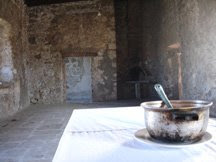
Michael Hebberoy Table Making / Breaking
Fritz Haeg Olympic Farming 2012
Sarah Rich From Footwear to FoodBALL
Eva Hagberg Scar Tissue
Stephanie Snyder The Master’s Table
Michael Hebberoy Table Making. Steps 1–8.
Bill Fritts Setting the Table
Peter Lewis Taste & Memory
Greg Lundgren, Matthew Stadler, Adam Kleinman Cook Books
Thorsten Baensch, Chrisine Dupuis Moveable Feat
TABLE MAKING / BREAKING
Michael Hebberoy
For the past one hundred years or so the Western world has been busily building a machine for eating. The blueprints for a glorious global mechanism to produce and distribute the golden jewels of the dirt were drawn up and revised while we hummed from Industry to Information. Now we are all involved and partake daily in this vast architecture. Like many of the armatures of modern design it has left us wanting. This machine may be a grand structure, but it is as cold as a freeway and the tastes it offers are about as complex.
When asked to feature edit this issue — ARCADE’s first sideways glance at the intersection of food and design — I had no clear picture of the patchwork that would form. Kelly had already shoulder-tapped a few respected writers, and I had less than a month to cull the rest of our content from sources far and wide. Strangely it was not a case of lack — the excitement to be involved bubbled over, and if we had pursued every interested party, every concept we had for these pages, you might have a 1,000-page brick of words and images.
The connections between food and design are ripe, rich and densely tangled. We didn’t set out to be macabre or political or really anything particular, but it is clear that this inquiry has hit a common pulse: nostalgia, a sense of loss and enthused commitment to solutions. Scars and personal transformation, broken tables, sweeping proposals to rip up London commons and plant strawberries, and in one case a pitch of anger so intense that a completely uncharacteristic act of violence played out in the night — the articles herein are not military marches, but they clearly respond to the context in which we currently walk, shop and eat. They look beyond Koolhaas’s eerie summation, “Shopping is arguably the last remaining form of public activity,” and suggest that eating can once again become public, vital and, at the risk of sounding overly romantic, passionate.
Bio. Michael Hebberoy studied literature at Reed College and architecture at Portland State University. After launching the City Repair Project, a guerilla architecture project, with artist/activist Mark Lakeman, Hebberoy turned to the table. In March 2001, Michael opened an unlicensed restaurant in his Portland rental home, called Family Supper, which quickly became the most visible underground restaurant in the U.S. In 2004, Hebberoy and chef Morgan Brownlow opened clarklewis to critical acclaim. Hebberoy now lives and works in Seattle. His recent work includes the launch of a new underground project called “one pot” (www.onepot.org).




